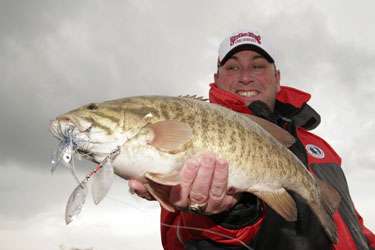
Your body — commonly called your core — is the lifesaving part of this series. It's not normally the first thing to get cold, but when it does it's bad news for you and your family.
"Keeping your body warm is not simply a matter of comfort. It's a matter of basic survival," says Rob McMahon, communications specialists for Mustang Survival. "And to do that you need to stay dry, dress in layers and break the wind."
Staying dry begins with your underwear. Change into fresh, dry skivvies just before you dress for the day. The shorts and tee shirt you wore to bed the night before absorbed body moisture during the night. That moisture will chill you to the bone as the day wears along.
Then make sure you choose the right long underwear. Some anglers like tight knits under heavier insulated styles. Others prefer just one, heavier layer. Either
way make sure everything fits properly and is snug at the wrists, ankles and neck. You don't want cold air working its way inside them.
Wear a warm pair of pants and shirt, or turtleneck sweater, over your long johns.
Last, but not least, is your outer shell. Consider the following four factors when choosing one:
1. Waterproofing. You don't want to get wet from the outside-in anymore than from the inside-out.
2. Windproofing. Make sure it'll stop the wind from cutting through to your body.
3. Insulation. The outer garment must be insulated to a level that'll work in your environment. Don't forget to consider body metabolism and movement. Too much is as bad as too little.
4. Flotation. Make certain your outer shell will keep you afloat in an emergency. Staying afloat in cold water, with three or four layers of clothing on, is no small task.
"As far a waterproofing and windproofing are concerned, Gore-Tex is a good product but it's not the only one around. We have some highly durable nylon waterproofing that works as well as anything on the market today," says McMahon.
"Quality and fit are what's most important. You want waterproof zippers, waist adjustments, a good wrist and ankle fit and a snug collar."
When choosing insulation and flotation, McMahon recommends AirSoft foam. "We use it in a number of our products. It's especially functional because it not only provides thermal protection, but it also provides buoyancy in the event you end up in the water for some reason."
He goes on to recommend that anglers consider a two-piece pant and jacket combo rather than a one-piece suit. "If a two-piece suit is made properly and fits properly, it'll keep you dry, warm and afloat if necessary. And, it offers the advantage of flexibility. You can remove one piece or the other if conditions change."
Keep in mind, however, that some flotation garments are Coast Guard approved and some aren't. Check before you buy if your state's regulations require such compliance.
And one final thought about quality outdoor clothing of any type — it isn't cheap. Check around. Prices for identical items vary widely from one retailer to another.




